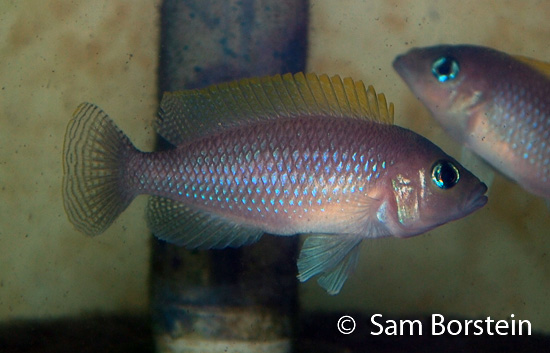'Lamprologus' caudopunctatus
(Poll, 1978)
Caudopunks
Synonyms: Neolamprologus caudopunctatus

Above: A male 'Lamprologus' caudopunctatus "Kapampa". Photo by Sam Borstein.
Etymology:
Genus- Lampas= Bright (Latin), lagos= hare (Greek)
Species- caudopunctatus= caudo= caudal (Latin), punctatus= spotted (Latin).
Intro:
'Lamprologus' caudopunctatus is a popular fish first typed by Poll in 1978 (type locality was Cape Kabeyeye). Caudopunks are an aggressive fish with a beautifully colored red-orange dorsal fin. This is an easy to keep and undemanding fish, granted you can deal with the aggression.
This fish is closely related to 'Lamprologus' leloupi. These similar fish can be differentiated by body pattern. 'Lamprologus' caudopunctatus has three stripes that run up its body while 'Lamprologus' leloupi has a chess board pattern (Konings, 1998).
Distribution:
'Lamprologus' caudopunctatus is found around the rocky areas throughout Lake Tanganyika's Zambian coastline.
Size, Maturity, and Sexual Dimorphism:
Size: Males- 4 inches, Females- 3.5 inches
Maturity: 1.75 inches
Sexual Dimorphism: Males are larger and have longer pelvic fins. females also have a rounder body shape.
Care:
'Lamprologus' caudopunctatus, although small, is pretty aggressive. They will do fine in a community tank, as long as they are put with fish with similar requirements that are bigger.
The tank should be decorated with rocks, caves, and plenty of shells. A minimum for a pair should be a heavily decorated 20 gallon. Ideally a larger tank like a 40 breeder or 4 foot tank could be used.
Diet:
'Lamprologus' caudopunctatus is a carnivore. In the wild they pick through the substrate looking for edibles. In captivity this fish is not picky and will feed on almost anything. Brine shrimp is beneficial to the diet of this fish, as it is many Lamprologus and I recommend feeding it.Breeding:
'Lamprologus' caudopunctatus is not difficult to breed. Although this fish spawns in rock crevices in the wild, it is not picky about spawning in aquaria and will spawn in terra cotta caves, cracks in rocks, and shells. The fish form very strong pairs.
Before spawning the aggression between males becomes quite obvious. The female also should be noticeably rounder. The fish guard their nest voraciously. It is common for them to cover the nest with substrate. The fry become free swimming in about 8 days, at which point the tiny fry come out for the first time. First food should be baby brine shrimp. The fry grow relatively fast for a Tanganyikan.
Conclusion:
'Lamprologus' caudopunctatus is an excellent fish. It is pretty and easy to keep. They are also easy to breed and show interesting parental behavior.
References:
- Konings, A. (1998) Tanganyikan cichlids in their natural habitat. Cichlid Press, El Paso, Texas, 272 pp.
